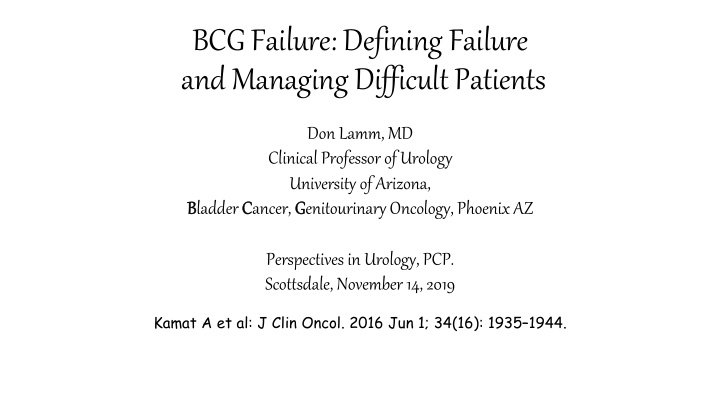



BCG Failure: Defining Failure and Managing Difficult Patients Don Lamm, MD Clinical Professor of Urology University of Arizona, Bladder Cancer, Genitourinary Oncology, Phoenix AZ Perspectives in Urology, PCP. Scottsdale, November 14, 2019 Kamat A et al: J Clin Oncol. 2016 Jun 1; 34(16): 1935–1944.
Study Groups • High risk: HG, T1 and/or CIS • Intermediate risk: LG multiple or recurrent • Low risk: Solitary LG, Ta, <3cm • BCG naïve: No BCG or none within 3 yrs • BCG Failure: • Refractory- increasing disease at 3 months or persistent at 6 • Relapsing- HG rec post CR/NED at 6 mo. Rec on 3wk maint or within 6 mo of last BCG • Unresponsive: any BCG failure; BCG intolerant; BCG unavailable
Ethics • Randomization to placebo or no treatment for CIS/high risk disease is considered unethical. Single arm studies are acceptable. • BCG unresponsive, defined as refractory or relapsing for whom further BCG is not appropriate, are also candidates for single arm studies. • BCG unavailable? Becoming an increasingly problematic group
Baseline Evaluations • Patient Demographics • Upper tract evaluation • Previous biopsy results: grade, stage, +/- CIS, #/size BT • Previous cytology • Prior treatment history • ? For high risk: previous prostatic urethra biopsies? Ureteral washes? Kamat A et al: J Clin Oncol. 2016 Jun 1; 34(16): 1935–1944.
End Points Primary • CIS: Complete response and duration of CR or RFS • Ta,T1: Duration of freedom from recurrence (RFS) • High grade: duration freedom from HG recurrence (RFS) • 1 year freedom from high risk recurrence (HG,T1, or CIS) Secondary • Time to progression, (increase in grade or stage); PFS, disease worsening: RC, RT, systemic chemo • OS • DSS • QOL, Toxicity, etc.
Expected Efficacy • BCG Unresponsive CIS: ~50% CR 6 months. OK in non-BCG failure patients; (MMC 52%, Doxorubicin 48%, Thiotepa 34%). 50% is too high for BCG failure pts, 30% is more reasonable. • BCG Unresponsive Ta,T1: 30% NED one year; 10% improvement in RCT
BCG Naïve Study • BCG Naïve: no prior BCG or no BCG within 3 years • High risk patients: BCG is standard, progression risk high, no treatment arm is unethical • Single arm study due to BCG shortage • Study drug vs chemotherapy*, no more than 1 yr maintenance • BCG 3 wk maintenance vs BCG plus study drug • BCG 3 wk vs study drug with side effect emphasis * Chemotherapy of choice is acceptable
Sample Size, Study Duration • For time to recurrence studies of resected Ta,T1 UC , if 70% are expected to be recurrence-free at 2 years about 450 patients would be required to show a 10% improvement to 80% recurrence-free (relative risk 37%, HR 0.63, p=0.05)
Low Risk Study • LG, Ta <3cm solitary tumor • TURBT plus immediate post op chemotherapy is standard • Randomized comparison of standard to study drug is ethical due to low risk of progression • Follow up: Cysto at 3 months and then every 6 months • Absolute reduction of 6% at 2 years is considered significant • RFS increase from 85% to 91% would require about 600 patients (RR 42%, HR 58%, p=0.05, beta 0.20)
Conclusions • New NMIBC drugs are much needed for BCG refractory, recurrent, intolerant, unresponsive and now –unavailable patients • Standard definitions, baseline studies, follow and end points will hopefully expedite approval • BCG unresponsive CIS, HG and T1 for whom RC is not an option are appropriate for single-arm studies. CIS CR of 30-50% at 6 months; 10% reduction recurrence vs repeat BCG would require 450 patients • Low risk solitary, LG, Ta, 3cm tumors: randomized trial vs post op chemo alone: 6% reduction would require 600 patients
Thank You!
Recommend
More recommend